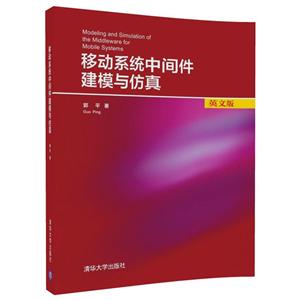移動系統中間件建模與仿真 版權信息
- ISBN:9787302491873
- 條形碼:9787302491873 ; 978-7-302-49187-3
- 裝幀:一般純質紙
- 冊數:暫無
- 重量:暫無
- 所屬分類:>
移動系統中間件建模與仿真 本書特色
本書主要介紹基于軟件架構的軟件建模與設計的相關知識,以移動系統作為例子,展示了如何使用基于和UML類似的元建模和圖形轉換技術來解決實際問題,主要內容包括問題領域、建模語言、軟件架構式樣、仿真技術、細化技術以及工具支持與代碼生成。本書不僅具有理論研究價值,而且具有較高的工程應用價值,對移動系統和軟件架構軟件建模感興趣的研究開發者和工程師具有很好的參考價值。
移動系統中間件建模與仿真 內容簡介
本書主要介紹基于軟件架構的軟件建模與設計的相關知識,以移動系統作為例子,展示了如何使用基于和UML類似的元建模和圖形轉換技術來解決實際問題,主要內容包括問題領域、建模語言、軟件架構式樣、仿真技術、細化技術以及工具支持與代碼生成。本書不僅具有理論研究價值,而且具有較高的工程應用價值,對移動系統和軟件架構軟件建模感興趣的研究開發者和工程師具有很好的參考價值。
移動系統中間件建模與仿真 目錄
Chapter 1 Introduction 1
1.1 Motivation:middlewareformobilesystems .......... 1
1.2 Problemswitharchitecture-centricapproaches......... 4
1.3 Objectivesofthebook...................... 7
1.4 Ourapproach........................... 10
1.5 Structureofthebook ...................... 13
Chapter 2 The Problem Domain 15
2.1 Overview ............................. 15
2.2 Middle
2.3 Middle
2.3.1
2.3.2
2.3.3
2.3.4
2.4 Middle
2.4.1
2.4.2
2.4.3
2.4.4
warefordistributedsystems............... 16
wareformobilesystems ................. 22
Mobilesystems...................... 23
Mobileapplications.................... 24
Problemswithmobileapplicationdevelopment .... 26
Middlewareformobilesystems ............. 27
wareformobilesystems:examples ........... 32
Event-based(orpublish/subscribe)middleware ... 32
Tuplespace-basedmiddleware ............. 36
Objectandcomponentmiddleware........... 39
Generalizationofcommonalities ............ 42
2.5 Aspectstobemodeled...................... 44
2.5.1 Modelingmobility .................... 44
2.5.2 Modelingotheraspects ................. 46
Chapter 3 Related Work 49
3.1 Overview ............................. 49
3.2 Requirements........................... 50
3.2.1 Requirementsforstylespeci.cation........... 50
3.2.2 Requirementsforthemodelinglanguage........ 53
3.3 Surveyofrelatedwork...................... 55
3.3.1 Surveyofarchitecturalstyles .............. 55
3.3.2 Surveyofmodelinglanguages.............. 64
Chapter 4 An Overview of the Approach 68
4.1 Overview ............................. 68
4.2 Thearchitecturalstyleforthemiddleware........... 70
4.2.1 Middleware-inducedstyle ................ 70
4.2.2 Layeredstructureofthestyle.............. 71
4.3 Themodelingandsimulationframework............ 73
4.3.1 Style-basedmodeling................... 73
4.3.2 Thestyleforthemiddleware .............. 78
4.3.3 Re.nement ........................ 79
4.3.4 Simulation ........................ 82
Chapter 5 Architectural Style-based Modeling 86
5.1 Overview ............................. 86
5.2 BackgroundoftheTGTS .................... 87
5.2.1 Graphsandgraphmorphism .............. 87
5.2.2 Graphsandobject-orientedmodeling.......... 88
5.2.3 Rulesandgraphtransformation ............ 89
5.2.4 Metamodeling ...................... 91
5.2.5 Typedgraphtransformationsystemandstylespeci.ca-tion ............................ 92
5.3 Speci.cationofthestyle..................... 94
5.3.1 Structuralpart ...................... 95
5.3.2 Behavioralpart...................... 97
5.3.3 Syntaxandsemanticsofthemodelinglanguage.... 101
Contents vii
Chapter 6 Style Examples 104
6.1 Overview ............................. 104
6.2 Themiddlewarefornomadicnetworks ............. 106
6.2.1 Architecturalcommonalities............... 106
6.2.2 Theconcretemiddleware:WirelessCORBA...... 110
6.3 Conceptualstyle ......................... 117
6.3.1 Structuralpart ...................... 118
6.3.2 Behavioralpart...................... 120
6.4 Platform-independentconcretestyle .............. 123
6.4.1 Structuralpart ...................... 123
6.4.2 Behavioralpart...................... 125
6.5 Platform-specificconcretestyle:WirelessCORBA ......... 133
6.5.1 Structuralpart ...................... 133
6.5.2 Behavioralpart...................... 137
6.5.3 IDLsemanticsspeci.cation ............... 147
Chapter 7 Style Re.nement 149
7.1 Overview ............................. 149
7.2 Requirementsforthere.nement ................ 150
7.3 Existingapproachesandopenproblems ............ 156
7.4 Rulemapping-basedstylere.nement ............. 158
7.4.1 Structuralre.nement .................. 159
7.4.2 Behavioralre.nement .................. 162
7.4.3 Re.nementoftheTGTS-basedstyle ......... 183
7.5 Evaluationandcomparison ................... 184
Chapter 8 Style Simulation and Tools 187
8.1 Overview ............................. 187
8.2 Graphtransformationsimulationtools............. 189
8.2.1 Requirementsforthetool ................ 189
8.2.2 AGG............................ 191
8.2.3 PROGRES ........................ 192
8.2.4 Fujaba........................... 194
8.2.5 Evaluationandcomparison ............... 195
8.3 Style-basedsimulation ...................... 198
8.3.1 Stylespeci.cationandsimulation............ 198
8.3.2 E.cientvalidation.................... 204
8.3.3 Re.nementconsistencycheck.............. 207
8.3.4 Behavioralconsistencycheck .............. 208
8.3.5 Style-basedengineering ................. 216
Chapter 9 Conclusion 219
9.1 Evaluation............................. 219
9.1.1 Evaluatingthestylespeci.cation............ 220
9.1.2 Evaluatingthemodelinglanguage ........... 221
9.2 Relevancetopractice....................... 224
9.2.1 Styleanddesign ..................... 224
9.2.2 Theconceptualstyleanddesign ............ 225
9.2.3 Theplatform-independentconcretestyleanddesign . 227
9.2.4 Theplatform-speci.cconcretestyleanddesign .... 229
9.3 Contributions........................... 230
9.4 Futurework............................ 234
9.4.1 Industryprojectexperience ............... 234
9.4.2 Automationandtoolsupport.............. 235
9.4.3 Developmentofotherarchitecturalstyles ....... 236
9.4.4 Modelbasedtesting ................... 237
Appendix OMG Wireless CORBA IDL 239
Bibliography 249
List of Figures 265
List of Tables 270
展開全部
移動系統中間件建模與仿真 作者簡介
郭平,現任職于昆明理工大學計算中心,曾獲得德國帕德博恩大學的計算機博士學位。主要研究方向包括軟件架構、軟件建模、移動和系統、嵌入式系統等。曾任職于西門子研發中心軟件工程師,德國國家印刷廠高級軟件架構師,Capgemini咨詢師等。















